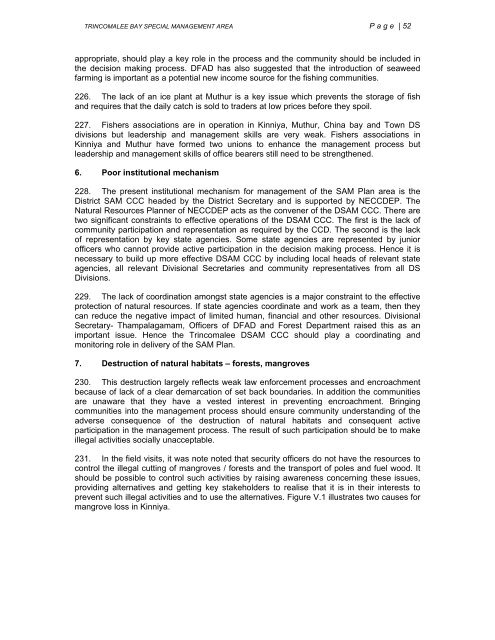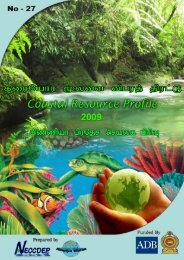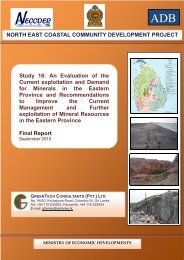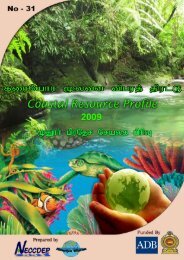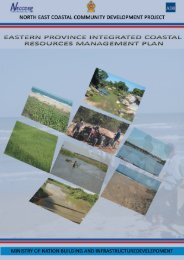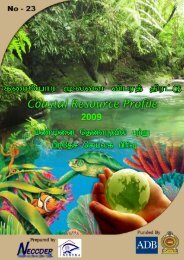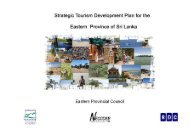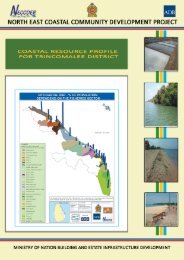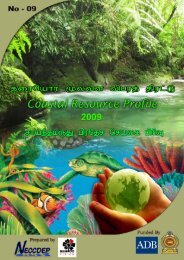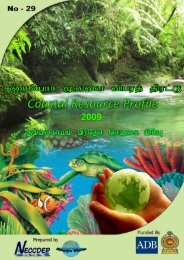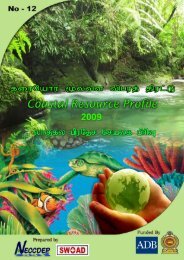Untitled - Neccdep.com
Untitled - Neccdep.com
Untitled - Neccdep.com
Create successful ePaper yourself
Turn your PDF publications into a flip-book with our unique Google optimized e-Paper software.
TRINCOMALEE BAY SPECIAL MANAGEMENT AREA Page | 52<br />
appropriate, should play a key role in the process and the <strong>com</strong>munity should be included in<br />
the decision making process. DFAD has also suggested that the introduction of seaweed<br />
farming is important as a potential new in<strong>com</strong>e source for the fishing <strong>com</strong>munities.<br />
226. The lack of an ice plant at Muthur is a key issue which prevents the storage of fish<br />
and requires that the daily catch is sold to traders at low prices before they spoil.<br />
227. Fishers associations are in operation in Kinniya, Muthur, China bay and Town DS<br />
divisions but leadership and management skills are very weak. Fishers associations in<br />
Kinniya and Muthur have formed two unions to enhance the management process but<br />
leadership and management skills of office bearers still need to be strengthened.<br />
6. Poor institutional mechanism<br />
228. The present institutional mechanism for management of the SAM Plan area is the<br />
District SAM CCC headed by the District Secretary and is supported by NECCDEP. The<br />
Natural Resources Planner of NECCDEP acts as the convener of the DSAM CCC. There are<br />
two significant constraints to effective operations of the DSAM CCC. The first is the lack of<br />
<strong>com</strong>munity participation and representation as required by the CCD. The second is the lack<br />
of representation by key state agencies. Some state agencies are represented by junior<br />
officers who cannot provide active participation in the decision making process. Hence it is<br />
necessary to build up more effective DSAM CCC by including local heads of relevant state<br />
agencies, all relevant Divisional Secretaries and <strong>com</strong>munity representatives from all DS<br />
Divisions.<br />
229. The lack of coordination amongst state agencies is a major constraint to the effective<br />
protection of natural resources. If state agencies coordinate and work as a team, then they<br />
can reduce the negative impact of limited human, financial and other resources. Divisional<br />
Secretary- Thampalagamam, Officers of DFAD and Forest Department raised this as an<br />
important issue. Hence the Trin<strong>com</strong>alee DSAM CCC should play a coordinating and<br />
monitoring role in delivery of the SAM Plan.<br />
7. Destruction of natural habitats – forests, mangroves<br />
230. This destruction largely reflects weak law enforcement processes and encroachment<br />
because of lack of a clear demarcation of set back boundaries. In addition the <strong>com</strong>munities<br />
are unaware that they have a vested interest in preventing encroachment. Bringing<br />
<strong>com</strong>munities into the management process should ensure <strong>com</strong>munity understanding of the<br />
adverse consequence of the destruction of natural habitats and consequent active<br />
participation in the management process. The result of such participation should be to make<br />
illegal activities socially unacceptable.<br />
231. In the field visits, it was note noted that security officers do not have the resources to<br />
control the illegal cutting of mangroves / forests and the transport of poles and fuel wood. It<br />
should be possible to control such activities by raising awareness concerning these issues,<br />
providing alternatives and getting key stakeholders to realise that it is in their interests to<br />
prevent such illegal activities and to use the alternatives. Figure V.1 illustrates two causes for<br />
mangrove loss in Kinniya.


